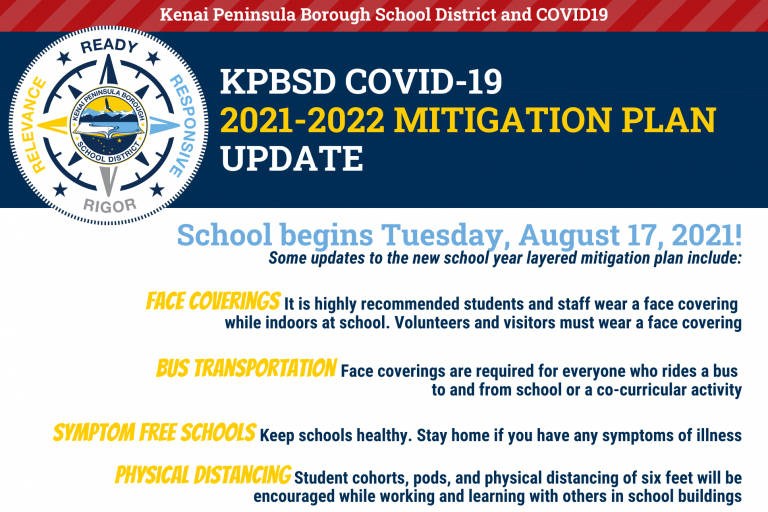The Kenai Peninsula Borough School District hopes to launch a COVID-19 tracking dashboard by the end of next week as a way to help better inform community members about the status of each school. More than 60 COVID-19 cases have been reported in 22 district schools, with Superintendent Clayton Holland announcing on Thursday plans for a more robust tracking system.
The district did not put their new internal COVID-19 tracking system in place until Aug. 23, KPBSD Communications Director Pegge Erkeneff said Thursday. As part of the new system, school nurses will report the number of positive COVID-19 test results from their school by 2 p.m. for the previous 24-hour period.
Erkeneff said it is not yet known whether the dashboard will report cases by region or by school, but that there will not be an individual dashboard for each of the district’s 42 schools.
The tracking efforts will add another layer to KPBSD’s comprehensive COVID-19 mitigation plan. That plan does not mandate the wearing of face masks, but offers rigorous protocols that largely come down to whether or not a student is vaccinated or not. Quarantine guidelines, for example, depend on several variables, with KPBSD following guidance from the Alaska Department of Health and Social Services.
The district’s current practice is to conduct contact tracing once it becomes aware of a case of COVID-19 in school. That involves notifying close contacts of someone who tests positive for COVID-19 that they are close contacts, and to have school principals send out correspondence to the school community informing them of a positive case at school.
“Today we learned about a positive COVID-19 case within our school,” that general letter says. “Contact tracing is complete, and everyone has been called who has been identified as a close contact.”
Holland said during a session with public health officials from the Alaska Department of Health and Social Services on Wednesday that the district has put also together its medical advisory team for the school year. Unlike during the 2020-2021 school year, Holland has assured community members that the identities of the team will be public. He said Thursday they include, among others, representatives from community health organizations like the Seward Community Health Center, South Peninsula Hospital and Central Peninsula Hospital.
Holland also clarified that the medical advisory team does not make decisions for the district, but rather is available to provide information to district administration.
“Those folks will be public,” Holland said Thursday. “(We’re) really trying to make this not about them making that decision. It’s about us making that decision. We’re getting advice. We’re talking to them about things but taking some of that pressure off of those folks as well.”
KPBSD announced last week that it would pause weekly antigen testing for student athletes due to supply chain shortages. Athletes still have daily symptom checks, but are only tested when symptomatic or for travel games to other districts. Erkeneff said Tuesday that the district’s new testing supplies arrived on the peninsula from Anchorage. The next step is to distribute those supplies to school and train staff for the molecular testing to symptomatic people at schools.
As of Saturday, Port Graham School, Susan B. English School and Tebugna School were all operating with universal masking, according to KPBSD’s COVID-19 dashboard. Nanwalek School was operating remotely due to a seven-day “hunker down” order issued by the local community authority, effective Aug. 25. The school is expected to open to onsite learning on Sept. 1.
KPBSD quarantine protocols
Unvaccinated, asymptomatic close contacts of someone who is COVID-positive must immediately quarantine. They can return to school one to two weeks after exposure once cleared by public health.
Unvaccinated, symptomatic close contacts of someone who is COVID-positive must immediately isolate. If that person tests positive, they must keep isolating. If they test negative, they must stay home while symptomatic or until finished with seven- to 14-day quarantine, whichever is longer, then talk to a health care provider and consider testing again before returning to school.
Vaccinated, asymptomatic close contacts of someone who is COVID-positive do not need to quarantine. They must get tested within three to five days of exposure, must wear a mask for 14 days and should carefully monitor for symptoms over the next two weeks.
Vaccinated, symptomatic close contacts of someone who is COVID-positive must get tested and immediately isolate. If that person tests positive, they must keep isolating. If they test negative, they must stay home while symptomatic, then talk to a health care provider and consider testing again before returning to school.
Regardless of vaccination status, symptomatic individuals with no known contact should immediately get tested and stay home. A positive test means that person must isolate for 10 days. A negative test means that person should stay home while symptomatic, then talk to a health care provider and consider testing again before returning to school.
The CDC distinguishes between quarantine and isolation. Isolation separates sick people with a contagious disease from people who are not sick, while quarantine restricts people who were exposed to a contagious disease to see if they become sick.
KPBSD’s full COVID-19 mitigation plan, as well as community case numbers and quarantine protocols for vaccinated and unvaccinated students is available on the district’s COVID-19 website at covid19.kpbsd.org.
Reach reporter Ashlyn O’Hara at ashlyn.ohara@peninsulaclarion.com.

